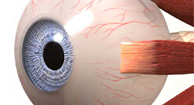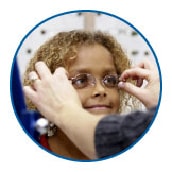This is a partial list of human eye diseases and disorders.
The World Health Organization publishes a classification of known diseases and injuries, the International Statistical Classification of Diseases and Related Health Problems, or ICD-10. This list uses that classification.
H00-H06 Disorders of eyelid, lacrimal system and orbit

- (H02.1) Ectropion
- (H02.2) Lagophthalmos
- (H02.3) Blepharochalasis
- (H02.4) Ptosis
- (H02.6) Xanthelasma of eyelid
- (H03.0*) Parasitic infestation of eyelid in diseases classified elsewhere
- Dermatitis of eyelid due to Demodex species ( B88.0+ )
- Parasitic infestation of eyelid in:
- leishmaniasis ( B55.-+ )
- loiasis ( B74.3+ )
- onchocerciasis ( B73+ )
- phthiriasis ( B85.3+ )
- (H03.1*) Involvement of eyelid in other infectious diseases classified elsewhere
- Involvement of eyelid in:
- herpesviral (herpes simplex) infection ( B00.5+ )
- leprosy ( A30.-+ )
- molluscum contagiosum ( B08.1+ )
- tuberculosis ( A18.4+ )
- yaws ( A66.-+ )
- zoster ( B02.3+ )
- Involvement of eyelid in:
- (H03.8*) Involvement of eyelid in other diseases classified elsewhere
- Involvement of eyelid in impetigo ( L01.0+ )
- (H04.0) Dacryoadenitis
- (H04.2) Epiphora
- (H06.2*) Dysthyroid exophthalmos it is shown that if your eye comes out that it will shrink because the optic fluids drain out
H10-H13 Disorders of Conjuctiva

- (H10.0) Conjunctivitis - inflammation of the conjunctiva commonly due to an infection or an allergic reaction
H15-H22 Disorders of sclera, cornea, iris and ciliary body

- (H15.0) Scleritis â€" a painful inflammation of the sclera
- (H16) Keratitis â€" inflammation of the cornea
- (H16.0) Corneal ulcer / Corneal abrasion â€" loss of the surface epithelial layer of the eye's cornea
- (H16.1) Snow blindness / Arc eye â€" a painful condition caused by exposure of unprotected eyes to bright light
- (H16.1) Thygeson's superficial punctate keratopathy
- (H16.4) Corneal neovascularization
- (H18.5) Fuchs' dystrophy â€" cloudy morning vision
- (H18.6) Keratoconus â€" degenerative disease: the cornea thins and changes shape to be more like a cone than a parabole
- (H19.3) Keratoconjunctivitis sicca â€" dry eyes
- (H20.0) Iritis â€" inflammation of the iris
- (H20.0, H44.1) Uveitis â€" inflammatory process involving the interior of the eye; Sympathetic ophthalmia is a subset.
H25-H28 Disorders of lens

- (H25-H26) Cataract â€" the lens becomes opaque
H30-H36 Disorders of choroid and retina
H30 Chorioretinal inflammation
(H30) Chorioretinal inflammation
- (H30.0) Focal chorioretinal inflammation
- Focal:
- chorioretinitis
- choroiditis
- retinitis
- retinochoroiditis
- Focal:
- (H30.1) Disseminated chorioretinal inflammation
- Disseminated:
- chorioretinitis
- choroiditis
- retinitis
- retinochoroiditis
- Disseminated:
-
-
- Excludes: exudative retinopathy (H35.0)
-
- (H30.2) Posterior cyclitis
- Pars planitis
- (H30.8) Other chorioretinal inflammations
- Harada's disease
- (H30.9) Chorioretinal inflammation, unspecified
- Chorioretinitis
- Choroiditis
- Retinitis
- Retinochoroiditis
H31 Other disorders of choroid
(H31) Other disorders of choroid
- (H31.0) Chorioretinal scars
- Macula scars of posterior pole (postinflammatory) (post-traumatic)
- Solar retinopathy
- (H31.1) Choroidal degeneration
- Atrophy
- Sclerosis
- Excludes: angioid streaks (H35.3)
- (H31.2) Hereditary choroidal dystrophy
- Choroideremia
- Dystrophy, choroidal (central areolar) (generalized) (peripapillary)
- Gyrate atrophy, choroid
- Excludes: ornithinaemia ( E72.4 )
- (H31.3) Choroidal haemorrhage and rupture
- Choroidal haemorrhage:
- NOS (Not Otherwise Specified)
- expulsive
- Choroidal haemorrhage:
- (H31.4) Choroidal detachment
- (H31.8) Other specified disordes of choroid
- (H31.9) Disorder of choroid, unspecified
H32 Chorioretinal disorders in diseases classified elsewhere
(H32) Chorioretinal disorders in diseases classified elsewhere
- (H32.0) Chorioretinal inflammation in infectious and parasitic diseases classified elsewhere
- Chorioretinitis:
- syphilitic, late ( A52.7+ )
- toxoplasma ( B58.0+ )
- tuberculous ( A18.5+ )
- Chorioretinitis:
- (H32.8) Other chorioretinal disorders in diseases classified elsewhere
H33 Retinal detachments and breaks
- (H33) Retinal detachment â€" the retina detaches from the choroid, leading to blurred and distorted vision
- (H33.1) Retinoschisis â€" the retina separates into several layers and may detach
H34 Retinal vascular occlusions
H35 Other retinal disorders
- (H35.0) Hypertensive retinopathy â€" burst blood vessels, due to long-term high blood pressure
- (H35.0/E10-E14) Diabetic retinopathy â€" damage to the retina caused by complications of diabetes mellitus, which could eventually lead to blindness
- (H35.0-H35.2) Retinopathy â€" general term referring to non-inflammatory damage to the retina
- (H35.1) Retinopathy of prematurity â€" scarring and retinal detachment in premature babies
- (H35.3) Age-related macular degeneration â€" the photosensitive cells in the macula malfunction and over time cease to work
- (H35.3) Macular degeneration â€" loss of central vision, due to macular degeneration
- Bull's Eye Maculopathy
- (H35.3) Epiretinal membrane â€" a transparent layer forms and tightens over the retina
- (H35.4) Peripheral retinal degeneration
- (H35.5) Hereditary retinal dystrophy
- (H35.5) Retinitis pigmentosa â€" genetic disorder; tunnel vision preceded by night-blindness
- (H35.6) Retinal haemorrhage
- (H35.7) Separation of retinal layers
- Central serous retinopathy
- Retinal detachment: Detachment of retinal pigment epithelium
- (H35.8) Other specified retinal disorders
- (H35.81) Macular edema â€" distorted central vision, due to a swollen macula
- (H35.9) Retinal disorder, unspecified
H36 Retinal disorders in diseases classified elsewhere
- (H36.0)
H40-H42 Glaucoma

- (H40-H42) Glaucoma â€" optic neuropathy
- (H40.0) Glaucoma suspect â€" ocular hypertension
- (H40.1) Primary open-angle glaucoma
- (H40.2) Primary angle-closure glaucoma
H43-H45 Disorders of vitreous body and globe

- (H43.9) Floaters â€" shadow-like shapes which appear singly or together with several others in the field of vision
H46-H48 Disorders of optic nerve and visual pathways
- (H47.2) Leber's hereditary optic neuropathy â€" genetic disorder; loss of central vision
- (H47.3) Optic disc drusen â€" globules progressively calcify in the optic disc, compressing the vasculature and optic nerve fibers
H49-H52 Disorders of ocular muscles, binocular movement, accommodation and refraction
- (H49-H50) Strabismus (Crossed eye/Wandering eye/Walleye) â€" the eyes do not point in the same direction
- (H49.3-4) Ophthalmoparesis â€" the partial or total paralysis of the eye muscles
- (H49.4) Progressive external ophthaloplegia â€" weakness of the external eye muscles
- (H50.0, H50.3) Esotropia â€" the tendency for eyes to become cross-eyed
- (H50.1, H50.3) Exotropia â€" the tendency for eyes to look outward
- H52 Disorders of refraction and accommodation
- (H52.0) Hypermetropia (Farsightedness) â€" the inability to focus on near objects (and in extreme cases, any objects)
- (H52.1) Myopia (Nearsightedness) â€" distant objects appear blurred
- (H52.2) Astigmatism â€" the cornea or the lens of the eye is not perfectly spherical, resulting in different focal points in different planes
- (H52.3) Anisometropia â€" the lenses of the two eyes have different focal lengths
- (H52.4) Presbyopia â€" a condition that occurs with growing age and results in the inability to focus on close objects
- (H52.5) Disorders of accommodation
- Internal ophthalmoplegia
H53-H54.9 Visual disturbances and blindness
- (H53.0) Amblyopia (lazy eye) â€" poor or blurry vision due to either no transmission or poor transmission of the visual image to the brain
- (H53.0) Leber's congenital amaurosis â€" genetic disorder; appears at birth, characterised by sluggish or no pupillary responses
- (H53.1, H53.4) Scotoma (blind spot) â€" an area impairment of vision surrounded by a field of relatively well-preserved vision. See also Anopsia.
- (H53.5) Color blindness â€" the inability to perceive differences between some or all colors that other people can distinguish
- (H53.5) Achromatopsia / Maskun â€" a low cone count or lack of function in cone cells
- (H53.6) Nyctalopia (Nightblindness) â€" a condition making it difficult or impossible to see in the dark
- (H54) Blindness â€" the brain does not receive optical information, through various causes
- (H54/B73) River blindness â€" blindness caused by long-term infection by a parasitic worm (rare in western societies)
- (H54.9) Micropthalmia/coloboma â€" a disconnection between the optic nerve and the brain and/or spinal cord
H55-H59 Other disorders of eye and adnexa
- (H57.9) Red eye â€" conjunctiva appears red typically due to illness or injury
- (H58.0) Argyll Robertson pupil â€" small, unequal, irregularly shaped pupils
Other codes
The following are not classified as diseases of the eye and adnexa (H00-H59) by the World Health Organization:
- (B36.1) Keratomycosis â€" fungal infection of the cornea
- (E50.6-E50.7) Xerophthalmia â€" dry eyes, caused by vitamin A deficiency
- (Q13.1) Aniridia â€" a rare congenital eye condition leading to underdevelopment or even absence of the iris of the eye






Retinitis pigmentosa is a chronic eye disease. If the patient of this disease don't treat it at the early stage then it may be the cause of permanent blindness. Best retinitis pigmentosa treatment
ReplyDelete